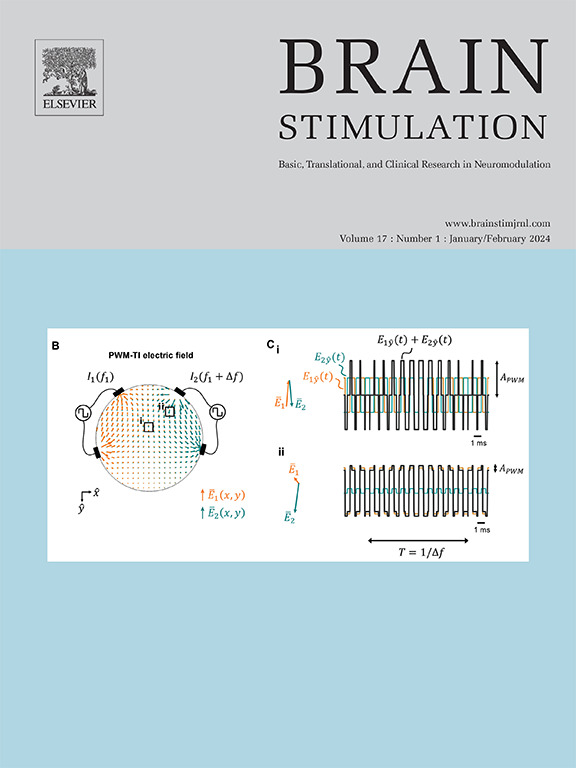额颞tDCS对多巴胺能传递和脑活动的调节:一项多模态PET-MR成像研究。
IF 8.4
1区 医学
Q1 CLINICAL NEUROLOGY
引用次数: 0
摘要
背景:经颅直流电刺激(tDCS)是一种很有前途的治疗精神分裂症的无创干预方法,尤其是在使用额颞叶蒙太奇时。尽管已经报道了显著的临床益处,但个体反应的可变性强调了对其潜在神经生理机制的更全面理解的必要性。在这里,我们使用正电子发射断层扫描(PET)和磁共振成像(PET- mr)方法同时研究额颞叶tDCS对健康个体多巴胺传递、脑灌注和白质微结构完整性的影响。方法:在一项双盲、双臂、平行组研究中,30名健康志愿者被随机分配接受单次活动(n = 15)或假(n = 15)额颞叶tDCS。刺激过程是在同时进行多模态PET- mr成像时进行的,该成像结合了PET与[11C]raclopride放射性示踪剂、动脉自旋标记(ASL)和扩散加权成像。结果:PET [11C]raclopride分析显示,与基线组和假手术组相比,活动组tDCS后15分钟左执行纹状体亚区不可置换结合电位显著降低。这一发现表明,额颞叶tDCS可能诱导多巴胺释放增加。ASL分析显示,与假刺激相比,活跃的tDCS可减少楔前叶的脑血流量。tDCS对脑白质微结构完整性无明显影响。结论:本研究对额颞叶tDCS的神经生理机制提供了新的认识,为优化皮质-皮质下多巴胺系统失调患者的治疗策略铺平了道路。本文章由计算机程序翻译,如有差异,请以英文原文为准。
Modulation of dopaminergic transmission and brain activity by frontotemporal tDCS: A multimodal PET-MR imaging study
Background
Transcranial Direct Current Stimulation (tDCS) is a promising noninvasive intervention for schizophrenia, particularly when applied using a frontotemporal montage. Although significant clinical benefits have been reported, the variability in individual responses underscores the need for a more comprehensive understanding of its underlying neurophysiological mechanisms. Here, we used a simultaneous positron emission tomography (PET) and magnetic resonance imaging (MRI) approach (PET-MR) to investigate the effects of frontotemporal tDCS on dopamine transmission, cerebral perfusion, and white matter microstructural integrity in healthy individuals.
Methods
In a double-blind, two-arm, parallel group study, 30 healthy volunteers were randomly allocated to receive a single session of either active (n = 15) or sham (n = 15) frontotemporal tDCS. The stimulation session was delivered during simultaneous multimodal PET-MR imaging, which combined PET with the [11C]raclopride radiotracer, Arterial Spin Labeling (ASL), and Diffusion Weighted Imaging.
Results
PET [11C]raclopride analysis revealed a significant reduction in Non-Displaceable Binding Potential in the left executive striatal subregion 15 min after tDCS in the active group, compared to both baseline and the sham group. This finding suggests that frontotemporal tDCS may induce an increase in dopamine release. ASL analysis showed that active tDCS may reduce cerebral blood flow in the precuneus compared to sham stimulation. No significant effects of tDCS were observed on white matter microstructural integrity.
Conclusion
This study provides new insights into the neurophysiological mechanisms of frontotemporal tDCS, paving the way for the optimization of therapeutic strategies for patients with dysregulated cortico-subcortical dopamine systems.
求助全文
通过发布文献求助,成功后即可免费获取论文全文。
去求助
来源期刊

Brain Stimulation
医学-临床神经学
CiteScore
13.10
自引率
9.10%
发文量
256
审稿时长
72 days
期刊介绍:
Brain Stimulation publishes on the entire field of brain stimulation, including noninvasive and invasive techniques and technologies that alter brain function through the use of electrical, magnetic, radiowave, or focally targeted pharmacologic stimulation.
Brain Stimulation aims to be the premier journal for publication of original research in the field of neuromodulation. The journal includes: a) Original articles; b) Short Communications; c) Invited and original reviews; d) Technology and methodological perspectives (reviews of new devices, description of new methods, etc.); and e) Letters to the Editor. Special issues of the journal will be considered based on scientific merit.
 求助内容:
求助内容: 应助结果提醒方式:
应助结果提醒方式:


